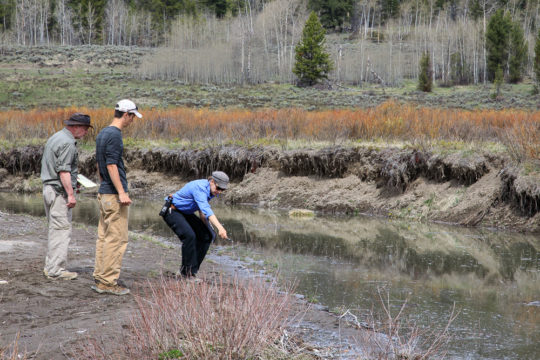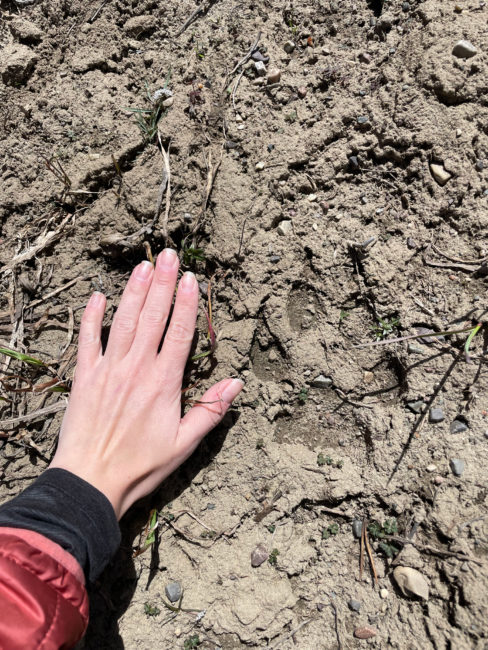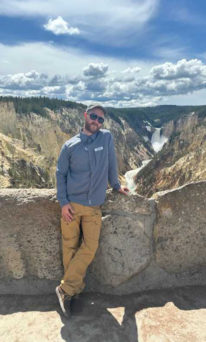Overview
Wildlife track and sign interpretation can bring an ecosystem alive even when the animals who have left their traces behind are long gone. It allows us to read stories on the landscape we might never witness firsthand. As guides, we use tracking as a tool to discern patterns of use and behavior in our local wildlife populations and to increase our odds of seeing the animals themselves in the wild. With some instruction, you can learn to do the same, whether in our National Parks or in your own backyard.
Highlights
- Learn the Basics of Recognizing Track and Sign on the Landscape
- Work to Identify Gait Patterns and Interpret Animal Behavior
- Link a Variety of Track and Sign to Paint a Broader Picture
Come out to explore the wealth of track and sign left behind by some of the most abundant and diverse populations of wildlife in North America. Our professional track and sign guides hold an internationally recognized Level 3 or Level 4 CyberTracker certification. With their instruction, a half day or full day immersive track and sign experience will open your eyes to an intricate world few people ever get to see.
This tour is van-based with ample time out of the vehicle for interpretation and instruction. Please come prepared for a variety of conditions and terrain.
Tracks are the footprints animals leave behind as they walk across the ground. Each species has a unique foot structure that allows us to link its footprint to its identity, and sometimes, upon close inspection, even its sex and age class. Once we’ve identified the maker of a single track we can step back to observe the larger pattern of tracks to see how the animal was moving and generate hypotheses about its behavior and mood.
While animals may take thousands of steps every day, only a small percentage of these will ever register as perfect tracks on the ground. Sign is every other trace an animal might leave behind, and is often found in great abundance. Scats, feeding signs, claw marks and antler rubs on trees all offer us windows not only into the lives of individual animals, but broader, landscape level stories as well.
We’ll travel to some of the richest habitats in Grand Teton National Park to discover a great variety of both tracks and sign, and help you understand who made them and what they were doing. You’ll come away with insight into an esoteric and timeless skillset, and a new appreciation for the unique and spectacular lives of wild animals.
Because tracks are continuously refreshed by the vagaries of wind and rain, and each day in the forest is different from the last, no two trips will ever be the same. We’ll travel by van to several locations each day, and we will use our short time in the field wisely. Our focus will be on track and sign, but when the opportunity arises we’ll observe wildlife we encounter, linking what we see elsewhere on the landscape to the movements and behaviors of living, breathing animals.
What's Included
-
Hotel pickup
-
Professional naturalist guide
-
Private safari
-
Light breakfast
-
Lunch (full day tours)
-
Assorted snack basket
-
Hot and cold beverages
-
Use of UHD binoculars and spotting scopes
-
Guide gratuities
-
National Park entrance fees
Private Safari - Half Day
Private Safari - Full Day
Pick-up Times
All guests are picked up and returned to their place of lodging. We pick up at hotels and condos in Jackson and Teton Village. Your exact pick up time will be determined by your hotel location and the season. Please make note of your pickup time, and save it for your reference.
Please give your guide an additional 5-10 minutes before and after the scheduled time to allow for other pickups or traffic conditions. Changes to trip timing may be made to accommodate daylight and/or optimum wildlife viewing.
Approximate pickup times for Jackson Hole include:
May 1 – September 14
- 6:30 AM
September 15 – October 31
- 7:00 AM
We had an exceptional guide with an impressive knowledge of the parks and their history, the wildlife and where to see them, and the interconnectedness of the ecosystem. We had an amazing grizzly encounter, and our guide also showed us plenty of elk, bison, pronghorn, and marmot. Best of all, he showed us his passion and love of what he does – and this made a great experience even more special.
Safari Tour Gallery
All photography has been shot by our talented tour guides.
FAQs
What is wildlife track and sign?
As animals move through an area, they may leave footprints behind. Each species leaves its own distinct set of prints behind and each of those prints can provide a wealth of information to a trained eye. When wildlife walks through an area, they also leave signs of their presence behind. This can include claw marks, scat, disturbed vegetation and more. When we step back and look at the tracks as well as the sign, it can provide valuable insights into animal behavior in our ecosystem.
What should we wear on a Grand Teton Track and Sign Adventure tour?
During the summer months, the weather and daily temperatures can be variable. It’s best to dress in layers that you can remove or put back on, as the day progresses or the weather changes. We recommend a lightweight synthetic t shirt with an expedition weight synthetic long sleeve top that you can put on in case the temperatures drop. A waterproof/breathable shell will keep wind and rain off if we experience sudden rain showers or if we head out on a rainy day. Hiking pants that you can roll up or zip off, if needed, are a helpful suggestion, for those days where we are moving from shady to sunny areas throughout the day. Sturdy hiking or walking shoes are a must – we will spend a lot of time outside of the van and will be traversing uneven ground at times. Bring sunglasses and a hat, and don’t forget to wear sunscreen! Our daytime temperatures may not feel as hot as you’re used to, but our high alpine rays can be especially intense.
Will we see wildlife in Grand Teton National Park?
While there is a good chance that we will see wildlife as we move the National Park, the goal of this tour is to explore where wildlife has been and learn to identify common track and sign. We will be looking for track and sign left by the wildlife, large and small, that inhabit the Greater Yellowstone Ecosystem. Learning track and sign is a valuable tool used by guides to successfully track and spot wildlife as it moves through the area. If your goal is to increase your chances at spotting wildlife, you can pair a Grand Teton Track and Sign Adventure with a Grand Teton Wildlife Safari Tour and put your track and sign skills to the test right away.
Who Are Your Tracking Guides?
A Brief History
(South Africa, 1995) CyberTracker Conservation is formed to identify remnant Master Trackers across the Kalahari, who join forces to create and initiate a process to train a new generation of trackers with remarkable effectiveness – the CyberTracker assessment and certification process is born. Now the international gold standard for Wildlife Tracker training, the CyberTracker system is applied around the world to develop professional-level tracking skill. The process is a multi-day evaluation of one’s skill and a rigorous training process, ensuring participants rapidly develop their understanding of the art of tracking, animal behavior, and ecology. Trackers return again and again to test their skill and continue their education among the best trackers in the world. Your guides are Level 3 certified trackers, individuals with an exceptional ability to read and interpret complex tracks and sign of wildlife—and not just those of large animals. They’re able to walk you through fascinating sign of all sorts of animals, from insects to birds to grizzly bears. Best of all, they’ll give you the basics that are essential to helping you learn to track back home.
Further Reading
Our Guides are Trained in Wildlife Track and Sign Skills – and Why You Should Be Too!
September, 7, 2017
I was also blown away by the depth of knowledge they had accrued about wildlife behavior. Not only could they find and follow even the slightest set of tracks, they could also intuit a large amount of information about the animal that had left the track and sign behind. With that knowledge they could make decisions on how to find (or avoid) the animal, they could use what they learned to teach us more about the animals and they could use the signs left behind to connect individual observations into larger patterns that gave them a deeper understanding of the animals over time.
Explore the Beautiful Wildlife of Grand Teton National Park
April 19, 2022
One of the most breathtaking mountain ranges in the U.S. is located in Grand Teton National Park. The pristine lakes and alpine terrain are made more spectacular by the profile of the Teton Range that acts as a backdrop like something out of a dream. The unique landscape of rocky mountains and dense forests has equally interesting wildlife to match. Explore some of the beautiful fauna you will find in Grand Teton National Park that you should be on the lookout for during your next visit.

















